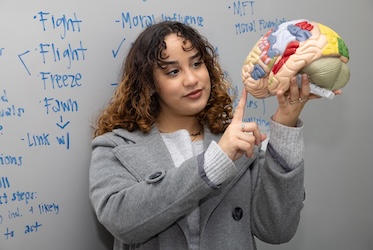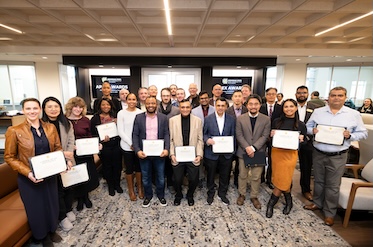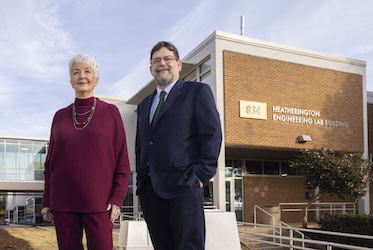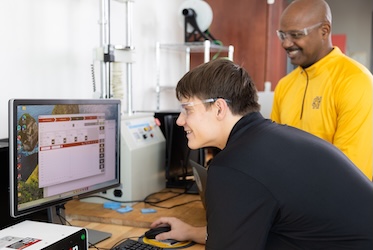

KENNESAW, Ga. | Feb 10, 2021
Kennesaw State University’s Office of Research is hosting a one-hour web show every other Friday at 4 p.m. to showcase the varied research being conducted by KSU faculty members. “Research with Relevance” spotlights Kennesaw State researchers in a live interview followed by an interactive question-and-answer session with the virtual audience.
This week’s episode features Laura Ruhala, associate professor of mechanical engineering; Richard Ruhala, professor of mechanical engineering; and Lance Crimm, professor of electrical engineering; all of whom belong to the Southern Polytechnic College of Engineering and Engineering Technology. The trio will discuss a recent study involving the acoustic qualities of different types of face masks. Prior to the presentation, each answered a few questions about their interest in research and its benefits to students.
Richard Ruhala: I got involved in noise control right after earning my bachelor’s degree in mechanical engineering from Michigan State University in 1991. I was fortunate to get an engineering position in automotive exhaust systems at General Motors. Hearing the reduction in noise or changes in sound using engineering methods got me interested in acoustics, which led me to earn my Ph.D. in Acoustics from The Pennsylvania State University. During my Ph.D., I developed and applied new acoustic imaging methods to study tire-pavement interaction noise. I enjoyed that research, but decided to take an industrial job as a staff engineer at Lucent Technologies developing new automotive cellular systems. After a few years there, Laura and I both searched for and secured tenure-track positions as I really missed the academic environment. That led us to the University of Southern Indiana and eventually to the Southern Polytechnic State University, now KSU. After 10 years at KSU, I have enjoyed seeing our program and university grow from a smaller, teaching-oriented institution to a large R2 university.
Laura Ruhala: In high school, I always excelled at math and science, so, even though I had very little hands-on mechanical experience, I was encouraged to become an engineer. Having grown up in Flint, Mich., then known as Buick City, being a General Motors engineer was considered a pinnacle of success. Unfortunately, though, I never had a real passion for automotive engineering until my last two years at GM when I became a Safety and Crashworthiness engineer. During my senior year of high school, I was a sole survivor of a horrific motor vehicle accident, so improving automotive safety was near and dear to my heart. Working in that department reignited my desire to continue my engineering education so that I could become a professor.
I first realized that I wanted to become a professor when I was a student at GMI Engineering & Management Institute, now known as Kettering University. The motor vehicle accident left me with permanent and painful physical disabilities, so I never figured that I would be physically able to be a professor if I couldn’t write on a board. During my sophomore year, I had a professor who used fill-in-the-blank teaching notes as his pedagogical method. This was the first time I had seen that delivery method, and he did this not because he was disabled, but because it was such an effective method. At that moment I had the “aha” that I could also be a professor.
Richard Ruhala: As long-time faculty, we didn’t have any startup funds or much university support to launch our research career when we joined. However a big break came when we got a course release in order to devote more time for research. Another big way that KSU has supported my research is with getting undergraduate students involved with directed study course credit. Some students are so excited about research they will even volunteer their time. I am glad to see KSU expanding internal and external research support.
Laura Ruhala: Our research team had two students actively involved in the data collection in November and December. The first student, Anaheeta Headjimirzaei, has since graduated from KSU with a degree in mechanical engineering. She is hoping to pursue graduate studies and wanted to gain some research experience. The second student, Andrew Pearce, is a mechanical engineering undergraduate student. He participated in the research as part of the requirements of his EE 4400 Directed Studies course. We currently have a third student involved as part of ME 4400 Directed Studies.. We currently have a third student involved, also as part of ME 4400 Directed Studies.
Richard Ruhala: I try to get at least one student involved each semester. They contribute to research projects and are encouraged to publish and present their findings. Learning is a two way street, and I learn a lot from the students as well as motivate to answer questions and apply results.
Crimm: We had one of my student assistants take an EE Directed Study to help with this initial phase of work along with another amazing student the Ruhalas' recruited. We plan to involve additional students for our upcoming listening study where we have consistently seen students more engaged when involved alongside faculty research.

Kennesaw State student explores how trauma affects decision-making

Top researchers recognized for achievements at Apex Awards

Lawrence Whitman installed as Dale and Ann Heatherington Endowed Chair of Engineering and Engineering Technology

Kennesaw State team innovates stronger 3D-printed structures through advanced simulations
A leader in innovative teaching and learning, Kennesaw State University offers undergraduate, graduate, and doctoral degrees to its more than 51,000 students. Kennesaw State is a member of the University System of Georgia with 11 academic colleges. The university's vibrant campus culture, diverse population, strong global ties, and entrepreneurial spirit draw students from throughout the country and the world. Kennesaw State is a Carnegie-designated doctoral research institution (R2), placing it among an elite group of only 8 percent of U.S. colleges and universities with an R1 or R2 status. For more information, visit kennesaw.edu.